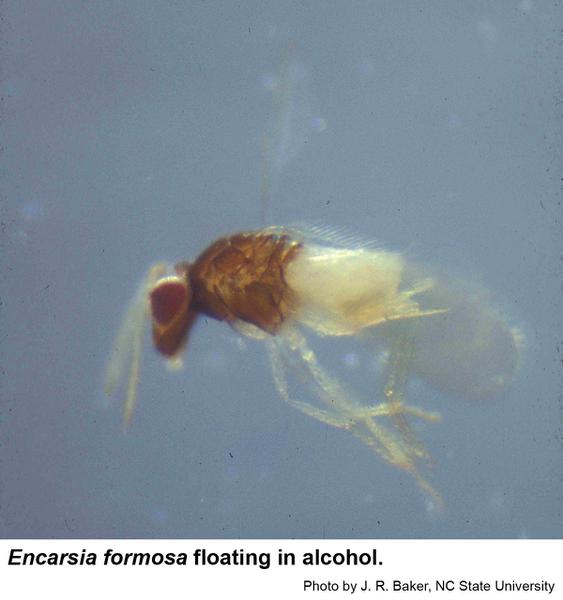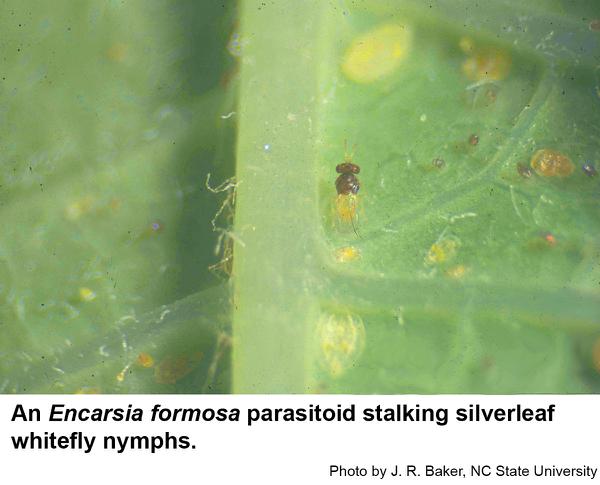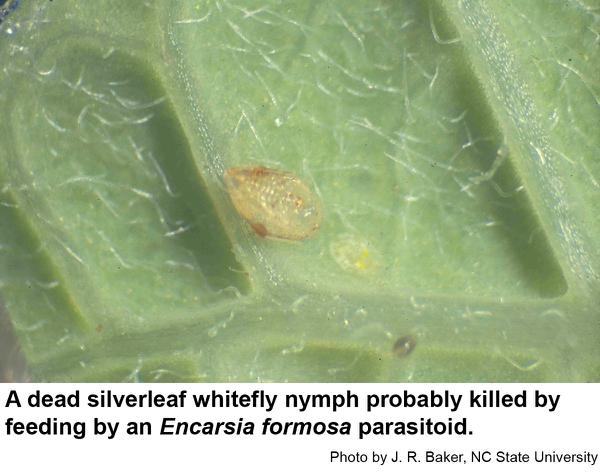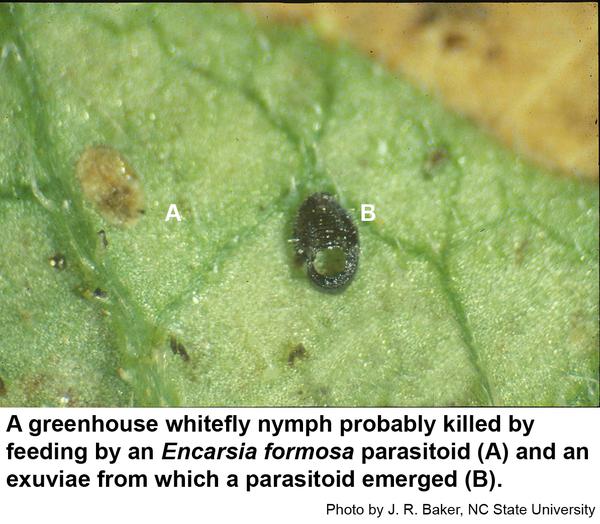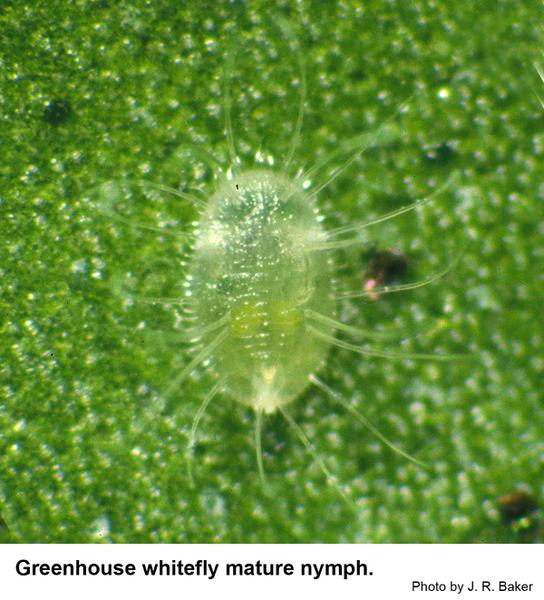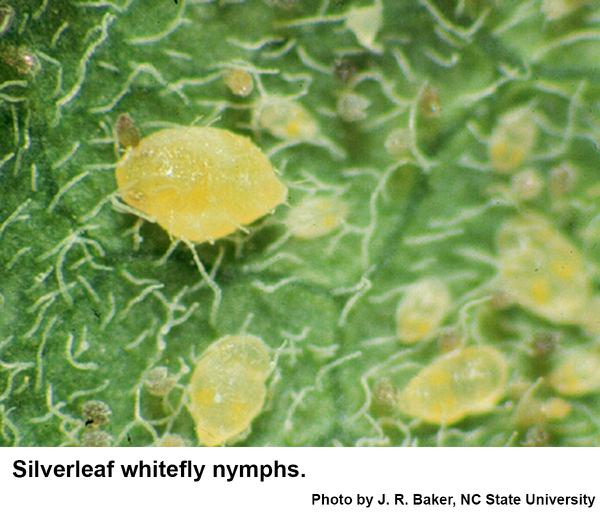Description and Biology
Encarsia formosa is a wasp less than 1/16 inch long that parasitizes greenhouse whiteflies, silverleaf whiteflies, and others (but is harmless to humans). The head and thorax are dark brown and the abdomen is light cream to yellow. Males are completely dark and are rare. First described from Colorado, it now has a cosmopolitan distribution because of releases into greenhouses worldwide. When searching for prey, Encarsia formosa walks over the tops, edges, and bottoms of the whitefly's host plant. Upon finding a suitable whitefly nymph, this parasite either injects an egg into the nymph or punctures the nymph and drinks hemolymph that oozes out. Host feeding often kills the immature whitefly. Encarsia formosa feeds on all immature stages except the egg, but it prefers second stage nymphs and pupae. Encarsia formosa also sips honeydew excreted by the whiteflies. Females lay five to ten eggs each day although older Encarsia formosa lay fewer. The wasp grubs hatch and mature into a new generation of adults into about three weeks. Adults chew a conspicuous hole in the upper surface of the dead nymph. Parasitized greenhouse whitefly nymphs turn black. Parasitized silverleaf whitefly nymphs darken slightly. Each Encarsia formosa kills about 95 whitefly nymphs during its life either by feeding or oviposition. Encarsia formosa seems to be a warm weather insect that is less effective below 75o F. Insecticidal soap can be used to kill adult whiteflies without killing Encarsia formosa grubs inside whitefly nymphs. Insecticidal soap does not leave a toxic residue, so it could be used the day before releasing Encarsia formosa without fear of harming these parasites.
Hosts
Encarsia formosa parasitizes at least 15 species of whiteflies on hundreds of ornamental, vegetable, and weed host plants.
Residential Recommendations
Encarsia formosa is available commercially. To use Encarsia formosa for biological control, there must be a resident population of whiteflies, otherwise these parasites disperse or die. If the whitefly population is severe, Encarsia formosa can be mass released as a “living insecticide,” but if whiteflies are scarce or moderately abundant, it can be released in small amounts to assure adequate suppression. Once a population of Encarsia formosa is established, it itself may become the victim of hyperparasites such as Signiphora coquilletti, Encarsia pergandiella, and Encarsia tricolor. Should the number of whitefly adults become too abundant, insecticidal soap can be applied without killing immature Encarsia formosa inside the parasitized whitefly nymphs (and without killing healthy whitefly nymphs as well). Because insecticidal soap does not leave a toxic residue, it can be used the day before Encarsia formosa are released without harm to the parasites.
References
- Biology and Use of the Whitefly Parasitoid Encarsia Formosa. Hoddle, M. S., R. G. Van Driesche and J. P. Sanderson. 1998. Annual Review of Entomology. 43: 645–69.
- Common name: Encarsia wasp, a silverleaf whitefly parasitoid (suggested), scientific name: Encarsia formosa Gahan (Insecta: Hymenoptera: Aphelinidae). Erich N. Schoeller, E. N. 2021. Featured Creatures. University of Florida, Entomology & Nematology, FDACS/DPI,| EDIS.
Publication Number: EENY-771 - Encarsia formosa, Hymenoptera: Aphelinidae. Hoddle, M. No Date (after 1998). Biological Control. Cornell University College of Agriculture and Life Sciences.
- Extension Plant Pathology Publications and Factsheets
- Horticultural Science Publications
- North Carolina Agricultural Chemicals Manual
For assistance with a specific problem, contact your local N.C. Cooperative Extension Center.
This Factsheet has not been peer reviewed.
Publication date: March 8, 2017
Reviewed/Revised: Dec. 21, 2021
Recommendations for the use of agricultural chemicals are included in this publication as a convenience to the reader. The use of brand names and any mention or listing of commercial products or services in this publication does not imply endorsement by NC State University or N.C. A&T State University nor discrimination against similar products or services not mentioned. Individuals who use agricultural chemicals are responsible for ensuring that the intended use complies with current regulations and conforms to the product label. Be sure to obtain current information about usage regulations and examine a current product label before applying any chemical. For assistance, contact your local N.C. Cooperative Extension county center.
N.C. Cooperative Extension prohibits discrimination and harassment regardless of age, color, disability, family and marital status, gender identity, national origin, political beliefs, race, religion, sex (including pregnancy), sexual orientation and veteran status.

